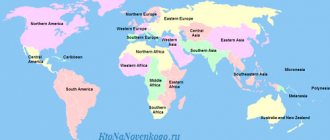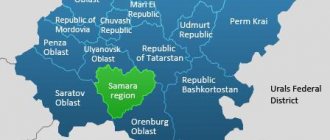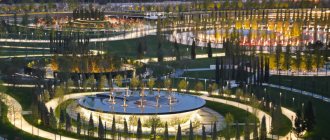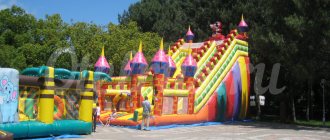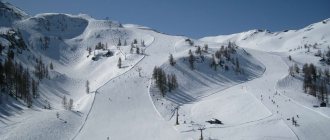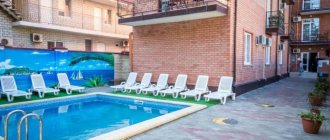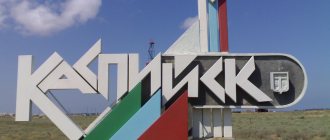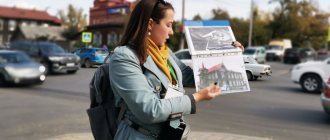In this overview post, we have collected detailed data about the districts of St. Petersburg. You don’t need to Google anything or search on our website yourself - everything has already been done for you: all the most current data has been collected, numbers have been checked, reviews and answers to frequently asked questions have been re-read and summarized. Everything you would like to know about the topic can be found in this post.
Important: we regularly update the information - as soon as something new appears about the districts of St. Petersburg, we immediately add it here. This way you will be aware of the latest news from TravelAsk!
St. Petersburg is a popular tourist city
Districts of St. Petersburg
St. Petersburg is a large city located on the Neva. Its area is 1439 km². 5 million people live here, St. Petersburg ranks second in Russia in terms of population, more people live only in Moscow. Therefore, it is not surprising that St. Petersburg is divided into 18 districts.
18 districts of St. Petersburg on the map
How to get to St. Petersburg from Moscow
You can get to St. Petersburg from Moscow in any way convenient for you - by car, bus, train or plane.
Flights depart daily from Vnukovo and Domodedovo airports to St. Petersburg. The flight takes about one and a half hours. This is the fastest way.
You can get to the northern capital using the services of the Sapsan high-speed train. It will take you from Moscow to St. Petersburg in 4 hours.
You can take advantage of the railway connection between the cities and set off on the Red Arrow and Lastochka trains from Leningradsky Station in Moscow. Travel time is approximately 7-8 hours.
There is another way to get to St. Petersburg - by bus. The method is not the fastest or most comfortable, but it exists. The time you will spend on the road is about 11 hours.
If you choose a car as your mode of transportation, you will also spend about 11 hours on the road. You can try to avoid traffic jams by driving along the M11 toll highway.
Vyborg district
This is one of the largest districts of the city, the territory size is 115.4 km², the population is almost 500,000 people. The area is located on the right bank of the Neva, in the central part of the city. Divided into two parts - residential and industrial. The environmental situation leaves much to be desired - there are a lot of emissions from different enterprises. But the authorities are trying to compensate for the pollution - they are organizing green areas, public gardens, and parks.
The area is relatively young, there are no problems with infrastructure - there are many shops, shopping centers, schools, kindergartens, hospitals.
Modern business centers and office buildings have been built.
Transport accessibility is provided by 6 metro stations and highways. Lots of public transport stops.
The real estate is represented by old houses, Khrushchev-era buildings in the center and elite residential areas, new buildings in the outlying areas.
Admiralteysky district
This is the historical center of the city, located on the left bank of the Neva. About 160,000 people live on an area of 13.82 km². This is the smallest district of St. Petersburg and one of the most popular among tourists. Many attractions of St. Petersburg are located here:
- Saint Isaac's Cathedral.
- Bronze Horseman.
- Yusupov Palace.
- Opera and Ballet Theatre.
The main buildings are buildings of the 18th century. Apartments here are expensive, especially those located near the water.
Top view of the Admiralteysky district
However, St. Petersburg residents themselves do not want to live in the Admiralteysky district. There are problems with infrastructure here - there is no space for the construction of large stores, shopping centers, hypermarkets, so you have to go to neighboring districts for shopping.
In addition, most of the residential buildings are dilapidated or in disrepair.
There are few trees here, but there are a lot of cars and public transport, and the air is polluted.
It’s difficult to leave here - there are constant traffic jams. Despite the fact that there are 9 metro stations open in the Admiralteysky district, this is not enough. The subway cars are filled to capacity, creating a crush during rush hour.
Vasileostrovsky district
Another central area of St. Petersburg beloved by tourists. It is located on three islands, the total area of which is 21 km². The population is about 200,000 people. Vacationers stay here for the attractions and proximity to the center - you can walk to Nevsky Prospekt.
But the locals don’t like to live here - there are many problems with transport. The islands are connected to the rest of the city by four bridges. Until 2016, during the construction of bridges from the Vasileostrovsky district, it was impossible to go anywhere by land transport. But after the opening of the WHSD section, the situation was resolved, and there were fewer traffic jams.
There are also metro stations built here, but their capacity is not enough; there are always a lot of people in the metro.
But real estate is still expensive. The area is built up with old housing stock, new panel buildings, and elite residential areas.
Vasileostrovsky district is located on three islands
THIS IS INTERESTING. Vasileostrovsky district is one of the oldest in St. Petersburg, it was founded in 1917.
Central single-mandate electoral district No. 216
District territory:
Districts: Admiralteysky, Vasileostrovsky, Petrogradsky. Municipal districts of the Central region: No. 78, Vladimirsky, Dvortsovy, Liteiny.
| Full name | Date of Birth | the consignment |
| Bogdanov Mikhail Yurievich | 23.10.1970 | Just Russia |
| Vishnevsky Boris Ivanovich | 17.04.1962 | Greens |
| Vishnevsky Boris Lazarevich | 15.10.1955 | Apple |
| Denisov Gennady Ivanovich | 09.03.1963 | Communist Party of the Russian Federation |
| Detkov Gennady Borisovich | 11.07.1958 | Pensioners Party |
| Ivanov Andrey Spartakovich | 02.04.1959 | Motherland |
| Ivanov Sergey Mikhailovich | 02.01.1986 | Civic Platform |
| Kovalev Alexey Anatolievich | 15.09.1963 | Party of Growth |
| Lebedeva Ekaterina Olegovna | 21.11.1980 | LDPR |
| Makoev Gennady Temurkanovich | 29.09.1948 | Communists of Russia (KPKR) |
| Sadovskaya Daria Sergeevna | 04.10.1993 | New people |
| Soloviev Sergey Anatolievich | 01.05.1961 | United Russia |
| Terekhov Alexey Nikolaevich | 03.03.1985 | Green alternative |
View detailed information about candidates for district No. 216 on the website of the Central Election Commission of the Russian Federation.
Kalininsky district
It is located in the north of St. Petersburg and covers an area of 40.12 km². About 500,000 inhabitants live here.
The area has a well-developed public transport network, many stops, and several metro stations. Hospitals, kindergartens and schools, a dozen institutes and universities were built.
The area itself is considered industrial; there are factories and other enterprises here. But they are mostly located in the southern part of the district, the northern territories are occupied by public gardens, parks and forests.
A large number of crimes are recorded in the Kalininsky district, so it is better to be careful here at night.
Active development of the territory is underway, with new residential areas being built every year. Real estate prices depend on the location of the house - the closer to the north, the more expensive.
Northern single-mandate constituency No. 213
District territory:
Vyborg district. Municipal districts of the Kalininsky district): Grazhdanka, Piskarevka, Finlyandsky.
| Full name | Date of Birth | the consignment |
| Antyukh Natalya Nikolaevna | 26.06.1981 | Pensioners Party |
| Gromov Nikolay Sergeevich | 24.06.1983 | Apple |
| Zvereva Anna Alexandrovna | 11.06.1983 | Green alternative |
| Ivanov Stanislav Dmitrievich | 01.04.1982 | LDPR |
| Ivanova Irina Vladimirovna | 03.01.1961 | Communist Party of the Russian Federation |
| Leshchev Ilya Mikhailovich | 15.08.1981 | New people |
| Marchenko Evgeniy Evgenievich | 17.07.1972 | United Russia |
| Romanovsky Sergey Anatolievich | 01.07.1982 | Civic Platform |
| Sibiryakov Sergey Anatolievich | 20.02.1970 | Greens |
| Tochilnikov Grigory Viktorovich | 05.10.1975 | Just Russia |
| Shpilenko Andrey Viktorovich | 27.07.1975 | Motherland |
| Vikhtyuk Oleg Viktorovich refusal to register | 14.07.1967 | Party of Growth |
| Kokonen Alexey Anatolievich refusal to register | 20.07.1977 | Self-nomination |
| Krigan Stepan Dmitrievich refusal to register | 21.11.1958 | Communists of Russia (KPKR) |
| Lipsky Andrey Vladimirovich refusal to register | 30.09.1988 | Self-nomination |
View detailed information about candidates for district No. 213 on the website of the Central Election Commission of the Russian Federation.
Kirovsky district
Over 300,000 people live here on an area of 48 km². The area has a favorable location in the north-west of St. Petersburg - on the shores of the Gulf of Finland. However, the entire shore is occupied by industrial enterprises, so you won’t be able to live with a view of the water. There is a poor environmental situation here, heavy gas pollution, dirty water. The area is one of the dirtiest areas in the city.
Transport accessibility is not satisfactory:
- 5 metro stations;
- Railway;
- several wide highways.
The housing stock is heterogeneous - there are both old dilapidated houses and modern buildings. Apartments in the Kirovsky district are cheaper than in neighboring districts, since it is considered an industrial zone.
The infrastructure is developed. There are many shops, canteens and cafes, dozens of educational institutions, including several private schools.
Tourists rarely come here, but there are a couple of interesting monuments and memorials. For example, the Narva Triumphal Gate.
The main attraction of the Kirov region is the Narva Triumphal Gate
Western single-mandate constituency No. 212
District territory:
Districts: Krasnoselsky, Petrodvortsovy. Municipal districts of Dachnoye and Ulyanka, Kirovsky district.
| Full name | Date of Birth | the consignment |
| Bragin Pavel Nikolaevich | 16.12.1988 | New people |
| Bulanova Tatyana Ivanovna | 06.03.1969 | Motherland |
| Golovanov Alexander Andreevich | 29.04.1973 | Party of Growth |
| Guryev Roman Alexandrovich | 09.12.1975 | Pensioners Party |
| Ivanova Tatyana Petrovna | 22.03.1961 | Communists of Russia (KPKR) |
| Itkin Pavel Mikhailovich | 17.06.1979 | LDPR |
| Kalugina Svetlana Radykovna | 15.08.1982 | Civic Platform |
| Menshikov Grigory Gennadievich | 23.08.1973 | Communist Party of the Russian Federation |
| Palevich Andrey Anatolievich | 06.07.1963 | Apple |
| Savelyeva Galina Sergeevna | 21.05.1984 | Freedom and Justice Party |
| Teterdinko Alexander Pavlovich | 20.11.1983 | United Russia |
| Tikhonova Nadezhda Gennadievna | 14.11.1973 | Just Russia |
| Utkina Olesya Vladimirovna | 21.05.1996 | Greens |
| Shestakova Olga Vladimirovna | 19.09.1982 | Green alternative |
| Evgeniy Vladimirovich Silantyev, who lost the status of a nominated candidate | 01.02.1975 | Self-nomination |
| Tsyganov Andrey Borisovich refusal to register | 05.10.1976 | Russian All-People's Union |
View detailed information about candidates for district No. 212 on the website of the Central Election Commission of the Russian Federation.
Kolpinsky district
This is one of the largest districts of St. Petersburg. Its area is 105.8 km². However, less than 200,000 people live in such a large area. This is a suburb of St. Petersburg. There are no metro stations and the public transport network is poorly developed. Despite the fact that the M-10 federal highway passes through the area, traffic jams are almost constant here.
The environment is bad. This is an industrial zone where there are about 30 large enterprises. At first, houses in the Kolpino region were built for factory employees. Then little-known construction companies came here, some of which turned out to be scammers. But recently, modern new buildings have begun to appear in the area, and apartments are actively being sold. Real estate is cheap. St. Petersburg residents do not want to move here, although the social infrastructure here is quite well developed.
South-Eastern single-mandate constituency No. 217
District territory:
Districts: Kolpinsky, Frunzensky.
| Full name | Date of Birth | the consignment |
| Averkin Igor Vladimirovich | 22.08.1977 | Communists of Russia (KPKR) |
| Gaisin Ruslan Radevich | 19.01.1981 | Just Russia |
| Gromova Elena Vladimirovna | 04.08.1974 | Green alternative |
| Dmitrieva Oksana Genrikhovna | 03.04.1958 | Party of Growth |
| Egorova Lyubov Ivanovna | 05.05.1966 | United Russia |
| Mikhnov - Vaitenko Grigory Alexandrovich | 03.09.1967 | Apple |
| Nezabudkin Andrey Sevirovich | 23.08.1976 | LDPR |
| Petrov Andrey Nikolaevich | 21.10.1976 | Motherland |
| Rumyantsev Dmitry Evgenievich | 01.04.1986 | Civic Platform |
| Sokolov Vyacheslav Vasilievich | 05.08.1982 | Communist Party of the Russian Federation |
| Shumilin Igor Dmitrievich | 02.05.1995 | New people |
| Shcherbakov Alexey Vladimirovich | 01.03.1976 | Pensioners Party |
| Salaev Alexander Rafikovich refusal to register | 15.08.1974 | Self-nomination |
View detailed information about candidates for district No. 217 on the website of the Central Election Commission of the Russian Federation.
Krasnogvardeisky district
Located in the north-west of the city on the right bank of the Neva. Its area is 56.83 km², the number of inhabitants is about 350,000 people. This is another industrial outlying area of St. Petersburg with poor ecology. There are about 50 industrial enterprises on its territory.
There are problems with public transport; getting to the city center during rush hour is problematic, despite the fact that two metro stations have been built here, and there are trolleybuses and trams.
The infrastructure is developed - many schools and technical colleges, shops, shopping centers. Museums, theaters, and libraries are open. There are few trees, there are practically no squares and parks - only the Rzhevsky Forest Park. But it is unkempt, and walking there in the evening can be dangerous.
Real estate is cheap. The housing stock is mainly represented by Stalinist and Khrushchev buildings, although new houses are still being built.
THIS IS INTERESTING. The first street art museum was opened in the Krasnogvardeisky district. It is located in an existing industrial enterprise.
Crime
The central district is one of the five most crime-prone areas of the Northern capital. In general, everything is clear and understandable - the city center attracts crowds of visitors, and their intentions are not always friendly. The Moscow Station also makes its contribution, regularly supplying criminals of various types - mainly, of course, swindlers and pickpockets.
There is rampant street crime - robberies are common in the dark, and a careless passerby can be robbed in broad daylight.
At the same time, law enforcement agencies are actively working and the number of crimes is steadily decreasing. All new cameras and terminals “Citizen - Police” are being installed, providing, if not the prevention of crimes, then at least the opportunity to solve it without delay. Simultaneously with the decrease in criminal offenses, the number of administrative offenses is growing. However, the overall trend is encouraging. For example, in 2011, the total number of registered crimes decreased by more than 12%, serious and especially serious crimes by almost 30%, murders by 40%, robberies by 14%, street crimes by almost 10% (compared to since 2010). So we can safely say that “life has become better, life has become more fun,” but you should be careful when leaving the house in the evening.
Krasnoselsky district
This residential area of St. Petersburg is considered the most environmentally friendly place in the city. There are practically no enterprises here, but there are many parks, squares, and forests. The territory is significant - 115 km². A little more than 400,000 St. Petersburg residents live here. A significant part of the area is occupied by settlements and the private sector, with many cottages.
The infrastructure is well developed - there are shops, medical facilities, kindergartens and schools.
Real estate is inexpensive, houses are mostly budget, but not always of high quality. However, active development of high-rise business-class buildings is underway. The transport problem is acute - there is not a single metro station here, and there is not enough public ground transport for all residents, and traffic jams often occur. It takes more than an hour to drive to the city center. By 2023, it is planned to open the Yugo-Zapadnaya metro station, which should improve the situation.
The most environmentally friendly district of St. Petersburg is Krasnoselsky
Kronstadt district
This smallest district of St. Petersburg (19.35 km²) is of interest to tourists, but not to locals. Just over 40,000 people live here. It is located on the islands in the Gulf of Finland. The only populated area is Kronstadt. It is located on Kotlin Island.
There are problems with both infrastructure and transport - communication with the main part of St. Petersburg is carried out via a dam. There is a lack of shops and entertainment facilities, but several schools and hospitals have been built. There are industrial enterprises.
The historical center of Kronstadt is a UNESCO heritage site. There are many attractions here:
- Naval St. Nicholas Cathedral.
- Summer garden.
- Italian Palace.
Resort area
It occupies a significant area of the coast of the Gulf of Finland - 267 km². However, slightly less than 80,000 St. Petersburg residents live here.
The point is expensive real estate - you can compare the Kurortny district with Moscow Rublyovka. This is a suburb of St. Petersburg with elite cottages. But there is also construction of multi-storey buildings with cheaper apartments.
The infrastructure is at a high level - there are shopping centers, shops, cafes and restaurants, gyms and beauty salons. There are many sanatoriums and health centers. There are good, well-maintained beaches.
The area is very green; 80% of all forest parks in St. Petersburg are located on its territory. This is an ecologically clean place with pine trees.
One of the beaches in the Kurortny district
There is no metro here, but the transport links are good and you can get to the city center without any difficulties. A railway has been laid and high-speed trains are running.
Southern single-mandate constituency No. 218
District territory:
Districts: Moskovsky, Pushkinsky. Municipal districts of the Kirov region: Avtovo, Knyazhevo, Krasnenkaya Rechka, Sea Gate, Narvsky.
| Full name | Date of Birth | the consignment |
| Burlakov Alik Viktorovich | 28.03.1985 | Greens |
| Duleba Valery Vladimirovich | 07.10.1963 | Communist Party of the Russian Federation |
| Krupko Sergey Vladimirovich | 04.07.1984 | Motherland |
| Krutov Andrey Dmitrievich | 18.02.1977 | Party of Growth |
| Lisovsky Sergey Anatolievich | 21.10.1965 | Pensioners Party |
| Lomakin Yuri Nikolaevich | 17.06.1985 | LDPR |
| Mashkova Ekaterina Vladislavovna | 29.01.1984 | New people |
| Milonov Vitaly Valentinovich | 23.01.1974 | United Russia |
| Oreshkov Boris Ivanovich | 01.08.1946 | Apple |
| Smirnov Alexander Vladimirovich | 05.10.1985 | Civic Platform |
| Tsymbalyuk Maxim Dmitrievich | 11.11.1995 | Green alternative |
| Shmakov Ilya Vladimirovich | 11.08.1971 | Just Russia |
| Sakharov Alexander Viktorovich refusal to register | 03.08.1970 | Communists of Russia (KPKR) |
| Shlakhter Tatyana Vladimirovna retired (after registration) candidate | 15.02.1969 | Freedom and Justice Party |
View detailed information about candidates for district No. 218 on the website of the Central Election Commission of the Russian Federation.
Moskovsky district
It is located in the south of St. Petersburg, covering an area of 73.05 km. About 350,000 people live here.
The area is green, quiet, quite cozy. Considered prestigious. The housing here is different - expensive elite high-rise buildings, Stalin buildings, Khrushchev buildings, and ordinary new buildings.
Moskovsky district is located near the center of St. Petersburg
The infrastructure is good - shopping centers, concert and exhibition halls, hospitals and clinics, shops. However, due to the active construction of residential buildings and population growth, there is a shortage of kindergartens and schools. But the problem is being solved, new institutions are being built. There are 6 metro stations open, public ground transport runs well.
Industry is also developed here, so in some parts of the region there is an unfavorable environmental situation.
North-Western single-mandate constituency No. 215
District territory:
Districts: Kronstadt, Kurortny, Primorsky.
| Full name | Date of Birth | the consignment |
| Ageeva Diana Vladimirovna | 13.05.1999 | New people |
| Andrusov Stanislav Borisovich | 28.12.1965 | Pensioners Party |
| Borodenchik Vyacheslav Ivanovich | 11.09.1964 | Communist Party of the Russian Federation |
| Gorlanov Alexey Vladimirovich | 14.07.1985 | LDPR |
| Karpenko Yuri Viktorovich | 05.02.1958 | Apple |
| Klinovitskaya Veronika Leonidovna | 27.11.1979 | Communists of Russia (KPKR) |
| Kolos Alexander Valerievich | 02.02.1980 | Motherland |
| Kuptsov Vsevolod Vyacheslavovich | 10.02.1980 | Freedom and Justice Party |
| Markov Igor Nikolaevich | 28.10.1956 | Civic Platform |
| Nilov Oleg Anatolievich | 08.05.1962 | Just Russia |
| Soloshenko Sergey Andreevich | 27.02.1990 | Green alternative |
| Tsed Nikolay Grigorievich | 06.10.1959 | United Russia |
| Yakovleva Olga Anatolevna | 31.05.1960 | Party of Growth |
View detailed information about candidates for district No. 215 on the website of the Central Election Commission of the Russian Federation.
Nevsky district
Its area is 61.79 km² and over 500,000 people live here. It is located on two banks of the Neva, the buildings are very dense. There are practically no places to build new houses. The housing stock is mainly represented by old houses from the Soviet period. But the government plans to demolish emergency and dilapidated housing to build modern buildings.
Now several new residential areas have been built on the left bank of the Neva overlooking the water and the River Station. Real estate prices here are very high, and the area is considered a prestigious place to live.
There are many shopping facilities, cinemas, restaurants, well-developed social infrastructure - there are sufficient medical and educational institutions.
But there are problems with transport, despite 6 metro stations. The area is connected to the center of St. Petersburg by three drawbridges. Their capacity cannot cope with the large number of cars and public transport, and traffic jams occur.
Cost of apartments in St. Petersburg by region
We begin our review with a rating of the most accessible areas.
Secondary market
Apartments with the lowest prices can be found in Krasnoselsky and Nevsky districts.
Krasnoye Selo, although it has long been part of St. Petersburg, essentially remains a suburban location. There are serious problems with transport accessibility here, the entrances/exits suffer from traffic jams, the metro is far away, and there will be no new stations in the foreseeable future.
But environmentally, things are excellent: there are large park areas nearby, not far from the Gulf of Finland. You can buy a one-room apartment here for about two million rubles! Considering the proximity of the bay, this is very profitable; in other areas with the sea coast there are simply no such prices!
Pricing in the Krasnoselsky district was influenced by transport accessibility
Let's move on to the Nevsky district. The cheapest housing here is concentrated in the south of the left bank - in the area of the Lomonosovskaya - Rybatskoye stations. Generous pricing is explained by the fact that here residential buildings are closely adjacent to industrial zones.
Accordingly, the ecology of the area suffers. But transport accessibility is well developed, there is a metro, close to the exit to the Ring Road, and major highways. The picture with social infrastructure is also positive. If we compare it with the Krasnoselsky district, then in many respects, except for ecology, Nevsky wins. True, housing here is a little more expensive.
As for prices, the average cost of a one-room apartment here ranges from 2.5-3 million rubles.
New buildings
In the primary market, Nevsky District is also the leader in terms of accessibility. The lowest prices are on the left bank, near the southern borders of the region. Inexpensive new buildings can also be found in the right bank part, away from the metro - Rusanovskaya, Prinevskaya streets.
Prices here are lower than on the secondary market - from 1.9 million rubles. For that much, for example, you can rent a renovated studio in the Prinevsky residential complex. The house is available for rent in 2021.
Suburbs
Although the material is dedicated to St. Petersburg, we could not help but consider the nearest suburbs. Their residents work in St. Petersburg, relax, shop, etc. In general, the border with the city here is purely formal.
We are talking about Murino and Kudrovo, where new residential areas are being formed. But if in Kudrovo prices have long “reached” the city level, then in Murino you can still find studio apartments within one and a half million rubles.
At the same time, Murino has its own metro, however, exits from the village are not the most convenient, and the infrastructure is still only developing.
Yuri, lives in the Greenlandia residential complex
“Low prices are really the main advantage of Murino. Because the region itself cannot yet be called coherent. Overall, fair value for money.
There are not enough schools and kindergartens. No large retail facilities, only supermarkets. At the same time, the population is constantly increasing, existing stores cannot always cope with the influx, sometimes you can stand in line for 10 minutes. It’s trite that you can’t buy equipment anywhere; you even have to go to the city to buy headphones.
There are also few entertainment venues, although there are still places to while away the evening. But the lack of parks is seriously annoying. Sometimes you just want to take a walk, but you have to go to Sosnovka. But you can get to it in just 10 minutes by metro.
In principle, everything is decided by going to St. Petersburg. For large purchases we go to Akademicheskaya or Mega, especially since minibuses constantly go to it (they stop opposite our house). Therefore, the presence of the metro is a huge plus; everything you need for life is within a 5-10 minute drive.
We expect the infrastructure situation to improve when Murino is finally given city status. But for now everything remains at the level of conversations and promises.”
Prices in the Materik residential complex start from 1.4 million rubles.
Petrogradsky district
It is located on the islands in the Neva delta, its area is 24 km². The population is just under 130,000 people.
It is in this area that the history of St. Petersburg begins - the Petrograd Fortress was founded here. This is the main attraction of the area due to which it is popular among tourists. Many hotels, hotels, and hostels have been built for them.
The area is green, there are many parks and squares. There are prestigious higher education institutions, private gymnasiums and schools, and many kindergartens here. Cafes, restaurants, and canteens are open.
Transport accessibility is not satisfactory; there are 6 metro stations, several drawbridges with wide highways, and public transport is good.
There are problems with real estate - there are few high-quality houses and elite neighborhoods, mostly old dilapidated buildings with communal services. But they are gradually being demolished, building up the territory with modern residential areas, the apartments in which are expensive.
Petrogradsky district is famous for its ancient and unusual buildings
Rating of St. Petersburg districts by quality of life
This category includes the “golden” areas of the city - with extensive infrastructure, good transport accessibility, excellent ecology and average prices for the city.
1st place – Vyborg district
The northern part of the city, an area that stretches from the suburban borders to the center. It is considered one of the best in St. Petersburg in many respects.
For example, in terms of transport accessibility. In the area there are 6 metro stations (two lines), 4 exits to the Ring Road and one to the WHSD, major highways and highways. The A-181 highway to Finland is nearby.
The existing road infrastructure provides a comfortable situation for residents of the area; traffic jams are more typical for the borders of the location than for the center. Although during peak hours congestion can occur in any part of the area.
Photo, caption: Vyborg district is a leader in many indicators
The situation with social facilities is positive: almost every quarter is provided with kindergartens and schools. There are enough medical facilities in the area. Things are a little worse with Pargolovo and Levashovo, but they too are gradually “overgrown” with the necessary facilities.
Everything is fine with the commercial and entertainment component! There are many shopping centers, hypermarkets, and entertainment venues in the Vyborg region. There are a large number of chain supermarkets. The MEGA Parnas shopping center is located on the border of the district.
Prices are reasonable. For example, a three-room apartment on the street. Yesenin, 7 minutes walk from the Pr. Enlightenment”, can be purchased for only 5.2 million rubles.
A huge advantage will be the presence of green areas, including the large-scale Sosnovka Park (302 hectares) and Shuvalovsky Park (142 hectares).
2nd place – Primorsky district
Another comfortable and convenient area located in the northern part of the city. In addition to good infrastructure and better ecology, it is also famous for the coast of the Gulf of Finland!
More recently, the district got rid of its “travel restricted” status. This was facilitated first by the commissioning of the WHSD, then by the opening of the Begovaya station. Now there are 5 metro stations in the area, and these are three different lines, one exit each to the WHSD and the Ring Road, major highways, including Primorskoye Highway, leading to the Kurortny district. True, the area has not yet been able to eradicate serious traffic jams during peak hours.
Photo, caption: Primorsky district has the best ecology and many new buildings
There are enough social facilities in the area. Although the population increases annually due to new housing, many new buildings are provided with their own infrastructure.
Among these, for example, is the Clear Sky residential complex with its own social facilities and even a sports complex! After full implementation, 8 preschool educational institutions (one is already operating), 4 schools and 2 clinics will appear in the area. Moreover, prices start from 2.1 million rubles.
Everything is excellent with a shopping and entertainment component. Residents of neighboring areas come here for shopping; there is no shortage of shopping centers. There is a water park. The main advantage of the area is its numerous large parks and its access to the Gulf of Finland.
3rd place – Moskovsky district
Prosperous, environmentally friendly area, close to the center. Historically, the Moskovsky district was home to intellectuals, political and cultural figures, which is why the location has long had a reputation as a prestigious place to live. The area also has aesthetic value: architectural masterpieces in the Stalinist Empire style are concentrated here.
Although there are 6 metro stations in the Moskovsky district, they all belong to the same line, which is not entirely convenient. But the ground transport network is well established. There are many major highways; motorists have no problems with mobility. A huge plus is the proximity to the airport.
The Moscow region is considered one of the most prestigious places to live
The Moscow region is famous for its educational institutions. These include kindergartens, schools, and universities. The district's provision of social infrastructure is excellent; residents of the district do not experience a shortage of educational or medical institutions.
Everything is great with a commercial component. There are hypermarkets and small shops here, and Moskovsky Prospekt is, in principle, a continuous shopping alley with designer boutiques. For leisure, there are many restaurants, entertainment venues, and bars. Cultural recreation is provided by theaters, concert halls, and cinemas.
There are enough parks in the area - Pobeda, Pulkovsky, Aviatorov, Oak Grove garden. There are neighborhoods with cozy squares. Although industrial zones remain here, the environmental situation is positive.
There are many offers in the Moscow region, both in new buildings and on the secondary market. We advise you to take a closer look at the Star Duet residential complex, which will be commissioned in 2021. The minimum price for the complex is 3.7 million rubles. For that much you can get a one-room apartment with an area of 35.7 m2 with pre-finishing finishing.
Petrodvortsovy district
It stretches along the southern coast of the Gulf of Finland and occupies 109 km². In fact, this is a suburb of St. Petersburg, an environmentally friendly place with a large number of green spaces, parks and squares.
Tourists come here for the sights:
- Peterhof;
- Oranienbaum;
- Konstantinovsky Palace.
Peterhof is the main attraction of the Petrodvortsovy district.
The social infrastructure is well developed - shops, kindergartens, schools, branches of large universities, medical institutions.
Mostly elite cottage communities and low-rise buildings have been built here. The area is prestigious, so real estate is expensive. About 140,000 people live here. The majority of the population has personal transport, which makes it easy to reach the city center along wide highways. There is no metro, but there is a railway, trains and electric trains run regularly. During the tourist season there is a shortage of public transport, and crowding is possible.
Ecology of the area
The environmental situation in the center of St. Petersburg, unfortunately, is far from ideal. The main source of air pollution (and the concentration of harmful substances in the air here is almost 3 times higher than the norm) is transit transport, which moves endlessly through the territory of the region every day. Naturally, the most polluted air is over the central highways of the region - Nevsky, Staronevsky, Ligovsky and Liteyny prospects.
Industrial enterprises also make their contribution: a motor depot on Korolenko, a thermal power plant on Sinopskaya embankment and an industrial zone along the Obvodny Canal embankment.
Green spaces partially save the situation (official statistics say that “greenery” in the region ranges from 10 to 25% of the territory). Moreover, most courtyards are not landscaped at all. Large parks and squares: Mikhailovsky, Admiralty and Tauride Gardens, Field of Mars, greenery around the Alexander Nevsky Lavra, Summer Garden, Garden named after. Chernyshevsky (it is located near Mytninskaya Street), parks around Smolny, public gardens on Kazan Square, Arts Square, Manezhnaya Square.
Tavrichesky Garden - an example of gardening art in the English style
Soil pollution in different microdistricts differs quite significantly. The dirtiest place is the part of the former Smolninsky district lying next to the Neva. It also has the highest rate in the city. The cleanest part is Nevsky Prospekt and adjacent streets - the average excess is no more than 5 times higher than the norm.
Water bodies (Neva, Moika, Fontanka and others) have a status from “moderate” to “dirty” - about the same as in the entire city.
The radiation situation is average in the city and has an acceptable level (10-16 µR/h).
Primorsky district
It is home to the largest number of St. Petersburg residents - almost 600,000 people. Area - 109 km². There is clean air and good ecology here. There are practically no industrial enterprises, but parks, squares and forests occupy a significant part of the territory.
The area is developing rapidly, new residential complexes are constantly being built. Real estate here is considered prestigious, apartments are expensive. Cottages and townhouses have also been built in the area.
Since many people live here, there is a shortage of kindergartens, schools, hospitals and clinics. However, there are plenty of shops, shopping centers and restaurants. 5 metro stations have been opened, a railway has been built, but the problem with transport accessibility has not yet been solved; there is not enough public transport for all residents. Owners of personal cars also often find themselves stuck in traffic jams, despite the fact that new road junctions and highways were built not so long ago. The area is located behind the railway, so congestion most often occurs behind the crossing.
Businesses and work in the area
The central district is primarily an area of business centers and banks. There are almost no industrial facilities here, and the workforce is dominated by white-collar workers. Qualified employees are almost always needed here, however, there is also work for those who do not have the knowledge and skills - vacancies for sales consultants in numerous boutiques and restaurant service did not dry up even during the crisis. The salary range varies sharply - from 10-15 thousand for trainees to 100-200 thousand for “financial tycoons”. The average salary for doctors, according to the administration, is 30,550 rubles, and for nursing staff - around 20,000 rubles; employees of enterprises receive an average of 30-40 thousand; salaries for teachers will also be maintained at approximately this level. There is a steady downward trend in unemployment and tension in the labor market.
for businessmen of all stripes, therefore there is a steady steady increase in small businesses and individual entrepreneurs (in 2011, 11.7% and 5.4%, respectively). The district administration willingly meets halfway and helps develop small and individual businesses, willingly accepting various support programs and subsidizing newly-minted businessmen.
In the center there is a huge number of small specialized shops, various offices, cinemas, restaurants and cafes of all kinds. Many of them are located on the first floors of former apartment buildings built in the 18th and 19th centuries. There are also many buildings erected specifically for trade enterprises, banks and hotels (House of Models, Aeroflot building, Eliseevsky store, Nevsky Palace hotel).
Nevsky Palace Hotel
The center also attracts the attention of various banks. Bank St. Petersburg has reconstructed and rebuilt three buildings for itself, and other banks are not lagging behind. And this is not counting the countless rooms in houses, where at every step you can find a bank branch or smaller office.
In 2011, Admiralteyskaya finally opened, and various investment projects are being implemented at more than 200 sites. In addition, a fairly large number (more than 6,000) of individual entrepreneurs are registered in the district, who also contribute to investments and the formation of the district’s budget.
The resettlement of communal apartments and the provision of housing to people on the waiting list are proceeding at a relatively fast pace. In 2011, 12 houses were resettled, all WWII veterans living in the area were provided with housing, and 155 families moved into new apartments. Targeted reconstruction of buildings is being carried out, including the building of the Main Internal Affairs Directorate on Liteiny. The Paradny and Smolny quarters are actively being built - in the future, each of them will become a full-fledged microdistrict with clinics, schools, shops and apartments for several thousand people. The projects of the first and second stages have been put into operation, the completion of the project is scheduled for 2014.
Front Quarter
The central region has practically no weight in the St. Petersburg industry, but several existing enterprises are iconic in their areas. This is the Spinning and Thread Mill named after S.M. Kirov; Haberdashery Association named after Bebel; Furniture association “Neva”, etc. At the same time, more than 250 thousand people work in enterprises and organizations, the average salary is about 39 – 40,000 rubles.
Shopping centers and markets are like dirt here - mainly, of course, the Gostiny Dvor and the famous Aprashka stand out, which, by the way, they have been wanting to demolish for a long time, making way for hotels, cinemas and prestigious residential areas, but there is an opinion that this market will also survive the current governor.
Aprashka
Pushkinsky district
It is located in the southeast of St. Petersburg, its area is almost 240 km². It ranks second in terms of territory size. About 220,000 people live here.
The area is suburban, located outside the ring road. There are few industries here and there are no environmental problems. There are many parks, squares, green corners. It's quiet, calm, cozy here.
Until recently, there was only prestigious real estate here - old houses near parks, expensive cottages. But now economy-class neighborhoods are being built, the apartments there are quite affordable.
There are several universities, technical schools, many schools and kindergartens.
There is one metro station built here, but most residents and tourists prefer to travel by train. In summer there are often traffic jams due to the large number of vacationers.
People mainly come here to visit Tsarskoye Selo and Pavlovsk.
Tsarskoye Selo is located in the Pushkinsky district
The best areas of St. Petersburg for living with children
This category highlights areas with the largest number of educational institutions and children's infrastructure.
central District
The city center is certainly good for everything, including educational institutions. There are a large number of public and private schools and prestigious gymnasiums.
There are music schools, the E. Obraztsova International Academy of Music, art schools, and vocal studios. All opportunities for the comprehensive development of children!
Petrogradsky district
Another great place to live with children is the historical part of the city. The atmosphere of classical St. Petersburg that reigns here seems to additionally contribute to the development of creative talents in children.
The Petrogradsky district has the best conditions for nurturing a creative personality
The B. Eifman Dance Academy, music schools, vocal studios and numerous sections are located here. Classical education is offered by schools, lyceums and gymnasiums. There are private institutions with in-depth study of languages.
Kalininsky district
Kalininsky differs favorably from the districts presented above due to its more affordable price category. At the same time, there are really many schools and preschool educational institutions, there is an Olympic reserve school, and creative clubs. Huge selection of sports sections.
Another significant advantage of the location is the low level of crime.
Frunze district
This is an area in the east of St. Petersburg, its area is 37 km². The number of inhabitants is about 390,000 people.
One of the oldest districts of the city. Today it is considered dormant, practically not developing. The buildings are dense, mostly panel apartment buildings. There is no new construction. Apartments are inexpensive. The infrastructure is good. Near the metro there are hypermarkets of famous chains, there are cafes, restaurants, beauty salons and gyms.
Universities, technical colleges, schools and preschool institutions were built. There are hospitals.
There are 7 metro stations open, but transport accessibility is still low. There is not enough public transport, there are always traffic jams on the roads, and few exits.
Population of the area
In terms of population density, the Central District has long been firmly ranked 1st in the city. According to the latest census, more than 215 thousand people live here. Of these, about 25% are pensioners, another 10% have not reached working age. As we can see, middle-aged citizens predominate (from 16 to 60 years old). The fair sex predominates in the area (55%). A very large percentage of the “temporary population” - tourists and migrants. The central district is the leader in the number of tourists staying - almost 25% of the city’s total room stock belongs to it.
The center has always been an expensive and prestigious place to live, which not every person could afford. Today this trend continues. Businessmen and middle- and senior-level employees, law enforcement and state security service employees who received departmental apartments live here; teachers of universities located here and their children and grandchildren (they live, as a rule, in corporate apartments received from their universities in Soviet times).
The picture is somewhat spoiled by the surroundings of the Moscow station, where visitors from different cities of Russia and the southern republics stay, sometimes even for several days. The station makes its significant contribution to the criminal situation - as a result. The central district is considered one of the most dangerous areas of the city. Although some parts of it are quieter and calmer than anywhere else - as a rule, these are the streets where embassies of different countries are located and, of course, the beginning of Liteiny Prospekt - few people would want to commit crimes under the invisible eye of “Big Brother”.
central District
It occupies a small area, only 17 km². Over 200,000 people live here. This is the historical center of the city, most of the buildings were built before 1917. There are many emergency and dilapidated buildings here, but real estate is still expensive. Especially those apartments that are located in the “golden triangle” - between the Neva, Fontanka, Admiralteysky Prospekt and Gorokhovaya Street. Apartments with a view of the Moika River are also highly valued.
Apartments with a view of the Moika in the Central district of St. Petersburg are expensive
The main attractions of the city are concentrated in this area.
- Nevsky Avenue.
- Singer's house.
- Admiralty.
- Kazan Cathedral.
Tourists prefer to stay here, so there are many hostels and mini-hotels located in the houses. There are cafes, canteens, restaurants, grocery stores, and souvenir shops.
Administrative and government buildings were built in the Central region.
11 metro stations are open, buses, trolleybuses, trams, and minibuses operate. Due to ground transport during rush hour, traffic jams form for many hours on the roads.
There are few trees, and the air is heavily polluted due to automobile fumes.
Eastern single-mandate constituency No. 211
District territory:
Nevsky district. Municipal districts of Ligovka-Yamskaya and Smolninskoye of the Central region.
| Full name | Date of Birth | the consignment |
| Abrosova Nina Alekseevna | 27.11.1983 | Motherland |
| Bakulin Vladislav Yurievich | 09.06.1962 | Party of Growth |
| Borzova Asya Gennadievna | 17.04.1991 | Greens |
| Gogolin Maxim Nikolaevich | 12.12.1986 | Pensioners Party |
| Goryacheva Ksenia Alexandrovna | 16.05.1996 | New people |
| Lozhechko Viktor Petrovich | 09.05.1952 | Just Russia |
| Romanov Mikhail Valentinovich | 03.11.1984 | United Russia |
| Sorokin Nikita Alexandrovich | 22.01.1987 | Apple |
| Stetsura Maxim Anatolievich | 18.12.1983 | LDPR |
| Khanina Ilona | 05.03.1975 | Civic Platform |
| Khodunova Olga Arkhipovna | 26.03.1955 | Communist Party of the Russian Federation |
| Savina Polina Yurievna refusal to register | 22.05.1995 | Communists of Russia (KPKR) |
View detailed information about candidates for district No. 211 on the website of the Central Election Commission of the Russian Federation.
